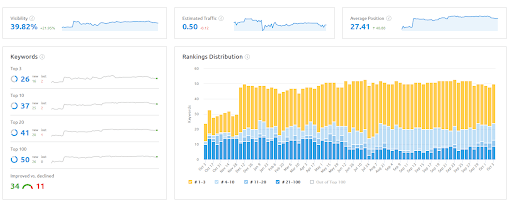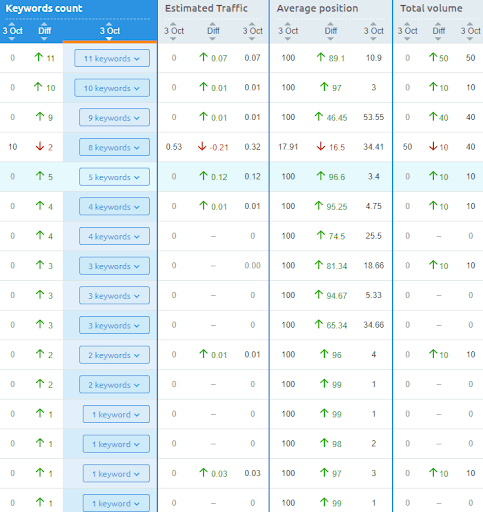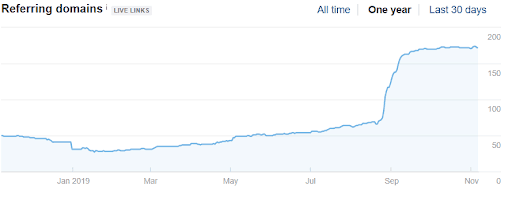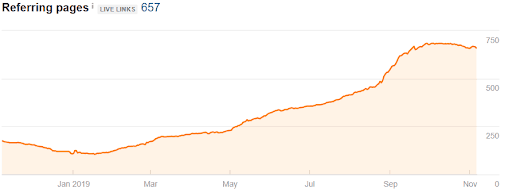10x more phone calls after a year of SEO work – Hispanic SEO Case Study
Getting results can be easy if you really know local SEO. Just setup Google My Business, do your on-page work, and build quality citations.
That’s usually enough to start generating a little traffic and then you can build up from there.
But what happens when your SEO client doesn’t want to target English language speakers in a US city at all? That’s the challenge we faced last year when we onboarded a law firm that targets the Hispanic community around their city. The following is a case study on doing local SEO with a focus on targeting immigrant populations.
Here’s a quick snapshot of where we are a year later:

BACKGROUND – Spanish Language SEO in the US?
When we first met with the client they explained that their firm had roots in the local community going back over a decade. The awareness was already there… They had handed out over 20,000 refrigerator magnets!
The firm’s big selling point – 100% of the attorneys and paralegals are fluent in Spanish.
So, we set out to do something completely unknown to us. My top concerns were:
- Extra time spent translating content
- Identifying keywords with search volume and buyers intent
- How do we secure links on Spanish language websites
- Differentiating our work from past brand awareness campaigns
Fortunately, these concerns were not much of an issue for us. As far as content and keywords goes, we were fortunate because the firm had an internal marketing team to help out with some writing.
Quantifying results was easy as well because we made it clear from the start that we would need to separate buyer intent traffic from branded traffic. Let’s look at how we did it all.
Using Google Translate
We translated entire pages and went about our normal on-page processes. Google Translate works so well now that the client’s internal content team didn’t really have very many edits to make on our content revisions.
Plus, so much of on-page SEO is really invisible to the user – Sitemaps, Robots, Schema, Proper Image Scaling etc. – so we didn’t have too much trouble overall. I would say that the language difference caused some additional work, but nowhere near what we were expecting.
Finding the right Keywords
Instead of jumping right into research mode, we set a meeting with the client to go over different buyer personas and learn more about the firm’s services.
Since they do accident and injury law, that was an obvious place to start due to the high ROI from this lead type. Search volume? It turns out I had nothing to worry about at all! It turns out over 30% of US searches are performed by people who speak both English and Spanish. Once we optimized the pages, the traffic started rolling in. Here’s what it looked like over the entire year.

Linking Domains – Does Language Matter?
It turns out this was another unfounded fear. We built almost all of their citations with English descriptions. We were concerned that the major directories in the US would think we were posting spam if we wrote in a foreign language, so we opted for our normal processes.
We did find a few Spanish publications to work with for guest posting later on, and those really helped with our targeted keywords on the organic side.
KEY TAKEAWAY – English language citations seem to work just fine for map ranking in this case.
Over the course of the year we saw steady gains as you’ll see below, and we only just started building Spanish language links over the summer months.

Branded Traffic versus Buyer Intent – En Español
Our last concern was to make sure we could justify our work to the client. They had been sponsoring events and running ads on the local Spanish radio station for years. We went into the campaign with the attitude that we would have to prove traffic wasn’t from a magnet that had been on someone’s fridge for 8 years collecting dust before they were hit by an 18-wheeler.
That’s easy to do with CallRail!
We setup call tracking numbers that were added to Google My Business, the website, and all over the web in the form of citations. These had never been used before in any of their past advertising. Here’s how we did in the first quarter:

Not a bad start, but it really picked up steam in the beginning of this year:

Then it got crazy in the Spring:

And completely bonkers in spite of everyone being at the beach over the Summer months.

We also made sure to point out stats like this so that the client knew most of the calls were not from branded search.

Hispanic Audiences – an Underserved Market in the US
As you can see from the call data above, the project was a total success over the last year. As Think With Google recently pointed out, Hispanics are an underserved market in the US when it comes to digital. Agencies and businesses should take note of this opportunity to reach a wider audience through local search optimization.
Did We Create Traffic? Is That Possible?
When I was looking back over the data, I saw something that reminded me of a recent claim someone made that SEOs can ‘create’ traffic through optimizing pages.
I guess the theory is that you can trigger some changes to Google Autosuggest with your optimization and people might select those terms. I suspect that at least partially explains the apparent change in search volume over the last year for several of these:

With these being Spanish keywords, I have to wonder if we’re the first in this particular local market to optimize a page for several of these? Or maybe it’s just that they have a larger Hispanic population than last year? Either way, it’s good to see numbers like this from SEMrush.
Specific Tactics
So how did we do it? I think the biggest boost came from consistent link building over the last year as evident from AHREFS:


We focused on the following link types early on in the campaign:
- Directory citations
- Branded profile links
- Legal niche directories
That gave us a lot of branded and naked URL anchors to ensure diversity. Then we moved on to more powerful links like:
- Niche edits
- Guest posts
- Media mentions
- Press release distribution
That last one was really powerful when it comes to map ranking. We embedded a Google map with the business address and contact info within a press release that was picked up on several media outlets.
It’s important to note that all of these listed above were done in English, including the press release.
Does the language of a linking page matter for local SEO?
The conclusion we came to was a resounding NO! The first Spanish language guest post was published sometime at the end of June. While I did notice a big boost from this, I think it was more due to the fact that this was a site with over 2 million visitors and simply a different link type that we had not really acquired yet.
Traffic and call numbers from before and after starting the Spanish guest posting campaign don’t really show a big difference over time.
KEY TAKEAWAY – Not only do English citations work, but all link types seemed to help, regardless of language. There was no significant difference when we started guest posting on Spanish language sites. Traffic and referring domains are still the primary metrics we use internally to evaluate a link opportunity.
Conclusion
I think there’s at least three big conclusions we reached working on this site for the last year:
- Marketers are missing a big opportunity by not targeting Hispanic consumers in Google
- Multilingual local SEO isn’t as challenging as it would seem
- Links work regardless of the linking pages language, at least up to a point
I could see this strategy working well for sites that already target English consumers for local search. Simply adding a /es version of all your main pages and doing some basic on-page could significantly boost traffic – practically overnight on a site with a competitive amount of referring domains…
Spanish language keywords have low competition in local search in the US, yet the traffic is there and it converts well. We can conclude that from our data, so maybe it’s time to suggest adding Spanish pages to your client site on the next strategy call?

